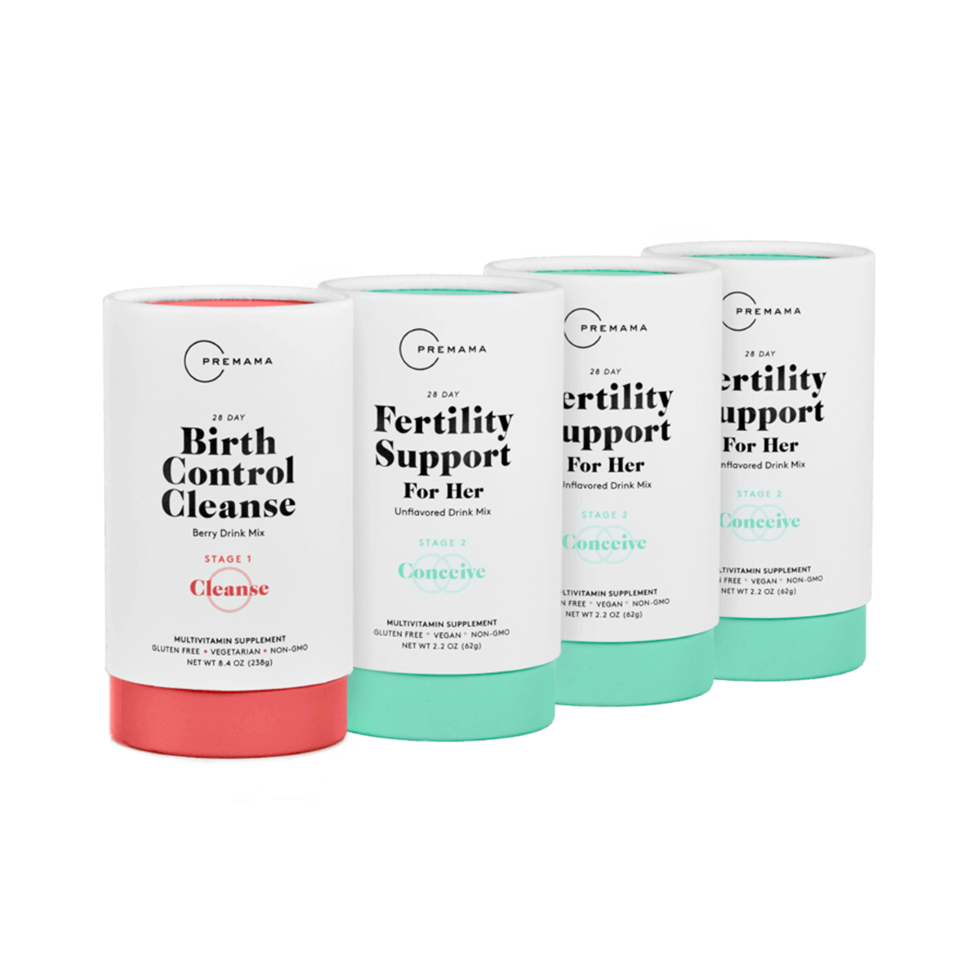
Making the decision to have a baby is a monumental moment. And if you’re there, let me be the first to say, “yay!” I am so excited for you and everything to come on your conception and parenthood journey. I also want to acknowledge that while this is exciting, trying to get pregnant can feel stressful—especially if you are hoping to get pregnant quickly. Once you make the decision, suddenly it seems like all you can think about is getting pregnant. So as you learn about how to conceive, and as you move through this chapter of your life, do what you can to be gentle with yourself, practice self-care and remember how vitally important you are. (Your future baby would agree).
In addition to taking good care of yourself, you probably have a ton of questions about how to get pregnant.
Before we dive into exactly how conception works, remember that your health care provider should always be your go-to for questions specific to you and your situation. Generally speaking, we say that if you are under the age of 35 and have been trying to get pregnant through sex for 12 months, or 6 months for those 35 and older, it’s time to reach out to your provider for support. But you can always check in sooner if you have concerns.
Without further ado, here is our 7-step, quick + dirty guide to getting pregnant fast.
1. Get prepared for getting pregnant.
If you have the opportunity to spend a few months focusing on your well-being before trying to get pregnant, it can be helpful. Here are a few ways to get ready for pregnancy:
- Schedule a preconception visit. This is an appointment with your provider (usually an OB/GYN or a midwife) where you can discuss your overall health as it relates to getting pregnant. You can also start discussing all the ways to get pregnant (sex and many assisted reproductive technology methods), and which option might be best for you.
- Start taking a prenatal vitamin with folic acid to help prevent spinal tube defects in your baby (taking it prior to getting pregnant makes it more effective).
- Stop taking birth control. But discuss this with your provider so they can help you figure out the best timing for you.
2. Decide: Wing it—or plan it?
If you are trying to get pregnant through sex, do you want to take more of a “let’s see what happens” approach to getting pregnant, or would you feel better charting and strategizing? Either is fine! And know that you can change your mind as you go.
If you decide to have a conception plan, then understanding your cycle is key.
3. Understand the menstrual cycle.
Your fertile window is five to six days long, typically in the middle of your cycle.
On average, those with a 28-day cycle will ovulate on day 14. But you are so not average! So charting your cycle is key to identifying your unique fertile days. In fact, just basing your conception attempts on a calendar can risk you missing your actual fertile days—your body will often show you that you are ovulation through specific signs of ovulation.
Ready to learn more? Here’s how to find your most fertile days.
Once an egg is released from your ovary, it will survive for 12 to 24 hours. That means that it must meet the sperm within that window in order for it to become fertilized. The good news is that healthy sperm survives in your body for up to five days.
This is why knowing when you ovulate is so important.
Say you ovulate on Wednesday at midnight. Having sex or insemination anytime on Wednesday means that the sperm is potentially going to meet the egg during that 12- to 24-hour window. But if you had sex or insemination on Tuesday (or Monday, or maybe even Sunday or Saturday), the sperm may still be alive and waiting for the egg when it’s released. So if you are anticipating ovulation within a few days, having sex or insemination will increase the chances of having living sperm ready to fertilize your egg.
4. Use apps and tests to identify your most fertile time.
Adding in apps and tests to help you identify your most fertile time can be really helpful. As I share in The Motherly Guide to Becoming Mama, “Some providers don’t recommend using ovulation predictor kits right away because they worry that we might become too reliant on the (not-foolproof) technology. If you miss the subtle physical body signs described above, you might miss your window of fertility.” Ultimately, you get to be the boss here and choose the method that works best for you.
If you decide to incorporate fertility apps and tests into your getting pregnant plant, here are a few to try:
- Ovulation strips (like these): Just pee on the strip. If the test line is as dark or darker than the control, you are likely fertile.
- Fertility monitors (like Kegg or Clearblue Fertility Monitor): These trackers can tell you when your fertility is low, high and peak.
- Apps (like Glow and Kindara): They allow you to track your period, ovulation signs and tests, intercourse and insemination, and even your sleep to help you determine your most fertile windows.
- Wearable devices (like Ava): When you wear it on your wrist overnight, this device detects changes in your body that indicate approaching ovulation.
5. Read your body’s signs of ovulation.
Here are the physical signs of ovulation to pay attention to:
- Cervical mucus: Cervical mucus is the normal vaginal discharge that changes as you progress through your cycle. It will go from nonexistent or dry to sticky, then creamy, and then wet, and then finally it will be the consistency of egg whites. That egg-white consistency means it’s fertile cervical mucus and indicates that you are about to ovulate. It’s the most sperm-friendly because they can easily swim through it up to the uterus.
- Basal body temperature drop: If you’re taking your temperature every day to chart your cycle using a fertility app or chart, you’ll notice that just as you ovulate, you may see a slight drop in your basal body temperature, followed by an increase.
- Cervical position: If you’re up for doing your own vaginal exam, you might note that your cervix is softer, higher and more open around the time of ovulation.
You may also experience slight pain/cramping, breast tenderness, spotting and an increased interest in sex around your ovulation window.
6. Have sex or plan your insemination.
If you are trying to get pregnant via sex, and you’re not tracking ovulation, have sex every other day all month long. If you are tracking ovulation, and your partner has an average or high sperm count, you can have sex every day in your fertile window. If they have a low sperm count, have sex every other day in order to boost the sperm concentration in the ejaculate (your provider can help you determine what your partner’s sperm count is).
One note: Sperm is healthiest when ejaculation happens every two to three days, so encourage your partner or sperm donor not to wait too many days between orgasms.
If you are trying to get pregnant via assisted reproductive technologies, your provider will likely be the one to help you time your appointments. If you are doing at-home insemination, using the apps and monitors above in addition to watching your ovulation signs will help you determine when it’s time.
7. Keep these pointers in mind.
- Do what feels right: Know that it’s a myth that any specific sexual position will improve your chances of conception.
- However, do try for an orgasm: “Orgasm can stimulate uterine contractions, which may help to promote sperm transport through the reproductive tract,” says Dr. Sanaz Ghazal, co-founder and medical director of RISE Fertility, and a double-certified fertility specialist.
- If you use lube, be sure it’s one that won’t inhibit conception: “Some vaginal lubricants can actually decrease fertility by having adverse effects on the sperm. Over-the-counter water-based lubricants like Astroglide, K-Y Jelly and K-Y Touch can decrease sperm motility by as much as 60-100%,” says Dr. Ghazal. Choose lubricants that are sperm-safe, like Pre-Seed.
8. Have fun!
I have a love-hate relationship with this piece of advice. Trying to get pregnant can become a bit stressful, and it’s OK to admit it. That said, see if you can find ways to make the process as enjoyable as possible. Take care of yourself and each other if you are partnered. Don’t force yourself to do anything that doesn’t feel right.
A version of this story was originally posted on January 16, 2020. It has been updated.
If you’re currently trying, we’ve got the goods you need for the journey in the Motherly Shop!
Premama vegetarian prenatal vitamins



With a gentle minty taste that’s gentle on your stomach, these non-GMO vitamins are formulated to support you with DHA, iron, folate and more.
Premama fertility support for him



Yes! Fertility support for fathers to be is now as easy as drinking a protein shake. This multivitamin supplement supports sperm health and comes in the form of a powered, strawberry vanilla drink mix. It takes two to tango, mama.
Premama birth control cleanse and fertility support conceive bundle


If you’re ready to start trying, this is the perfect conception support kit for you. You’ll begin with a Birth Control Cleanse drink mix to regulate the uterus and liver. Then transition to Fertility Support for Her to promote conception. Made with nourishing, gluten-free, vegetarian ingredients, the drink mixes easily blend with any non-carbonated beverage.
We independently select and share the products we love—and may receive a commission if you choose to buy. You’ve got this.

 PARENTING TIPS
PARENTING TIPS PREGNANCY
PREGNANCY BABY CARE
BABY CARE TODDLERS
TODDLERS TEENS
TEENS HEALTH CARE
HEALTH CARE ACTIVITIES & CRAFTS
ACTIVITIES & CRAFTS


